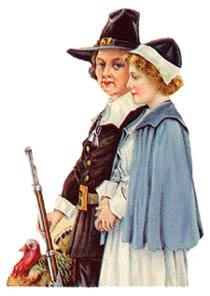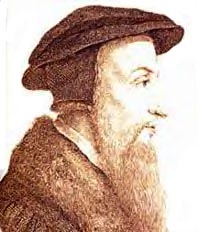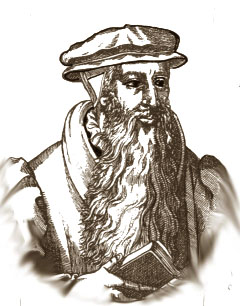

Puritanism
Written and researched by Margaret [nee Knight] Sypniewska, B.F.A.

HOW THE PURITAN MOVEMENT BEGAN:
The Puritans meant to purify the Protestant faith in England and New England. They worked with zeal to honor their God, and to seek rewards to show that God approved of their efforts.
The merge of Church and State in service to a hierarchical social order gave political significance to every religious issue. Church and State were united in early modern England. Law demanded that everyone supported the official Church of England with taxes and regular attendance. Religious dissent was considered treason and heresy. The crown employed the Anglican Church to promote political and religious conformity. Church courts (without juries) gave the crown the right to take revenue and to punish dissidents. The monarch also instructed the clergy to preach on issues that supported the king's policies. So you see the merge of Church and State gave a political significance to every religious issue
Puritan reformers wanted to change the Church of England and the society at large. Puritans saw the Anglican Church as a mixture of Catholic and Protestant doctrines and ceremonies. The bishops and archbishops were like Catholicism, and the king took the place of the Pope as head of the Church. Puritans wanted less church ceremony and more formulated prayers. There were no priests giving ceremonial sacraments.
Roger Williams was a clergyman who was moved to Rhode Island to practice his theories and he was for the separation of church and state so that ALL could practice without being forced into another's religion.
READ the above link as this article explains it better than most do.
Puritans wanted all its people to read and write and use The Bible to seek God. They encouraged thrift, diligence, and they thought that work was its own reward. There were Puritan laws against thieves, drunks, idle hands, prostitutes, and blasphemers.
The Puritans believed that further reformations were required, in regards to the Church of England, under Elizabeth I and the Stuarts. Puritans and Catholics alike, saw the establishment of the Church of England as being tainted by the fact that it was established by a desperate man, who sought heirs, no matter what the consequences. Henry VIII made himself leader of the Church of England, quite simply because the Catholic Church would not grant him his divorce from Catherine of Aragon. In the early days, the Church of England seemed to be merely a form of Catholicism that allowed divorce.
The Church of England (by Henry VIII's orders), dissolved all Catholic Monasteries. Henry's first wife, Catherine of Aragon, was a strict Catholic, as was her daughter, Mary I. After his association with Anne Boleyn, Henry learned more about Protestanism. Elizabeth I and Edward VI were both raised Protestant. England was tossed back and forth as each heir took the throne. First in line was Edward VI, as the only male heir. Edward upheld the doctrines of the Church of England, as the State and Royal religion of choice. When Edward IV died of congenital disease, passed on by his father, he asked that Lady Jane Gray be his heir to the throne, since she was from the line of his of his father's sister, and since Edward did not wish to have his half-sister, Mary, bringing back Catholicism. Jane was a pawn, and because of treachery, was executed for treason. Mary I wanted the throne, and she was afterwards known as "Bloody Mary," since many were punished and killed during her reign. Then Elizabeth I came to the throne, upon the death of her hated sister.
Scotland was still Catholic and Mary Queen of Scots was Elizabeth I's greatest threat. Against her best wishes, Elizabeth was ordered to sign a paper bringing about her cousin's death. Through all this, England was in a state of upheaval. Neither side was innocent and many lives were ruined or lost during this era.
NEW ENGLAND PURITANS:
They crossed the Atlantic Ocean in 1620, from Leyden, Holland. Holland allowed Puritans to practice their new religion, while England did not abide their criticisms of the Church of England. They came on The Mayflower first, and it was followed by many other ships. They founded Plymouth on the south shore of Massachusetts Bay. In 1620-1621 half of the colonists did not survive their harsh winter. But by 1630 there were 1,500 English in Plymouth Colony. Puritan men elected their governor, deputy governor and legislature (the General Court). John Winthrop was their governor until his death in 1649.
Land in New England was abundant but Puritan farmers had to rely on their own families for the labor to build their especially demanding farms, so Puritans generally had large families. Puritans DID NOT exploit servants and slaves. Some of the richer Puritans might have had only one house slave.
JOHN CALVIN AND JOHN KNOX:
Two major influences were John Calvin and John Knox. I will examine both of these men on this page.
JOHN CALVIN

John Calvin was born Jan Chauvin, on July 10, 1509; at Noyon, France. His father was Gerard Chauvin. His mother died when he was still young, and his father remarried. Gerard was secretary to the bishop, proctor in the cathedral chapter, and fiscal procurator of the country. In 1521, his father sent John to prepare for the priesthood, at the College de la Marche at the University of Paris. John was registered as "Johannes Calvinus," and he learned to write excellent Latin there. Calvin then attended the College de Montaigu, where he remained until 1528. This was also the college of Ignatious Loyola, founder of the Jesuits. Many described John as a shy and pious student, with a "severe censor of his comrades morals," yet loved by his friends, who seemed loyal to him and his causes. After Calvin received his B.A. and M.A. degrees, his father sent him to the University of Orleans, where he obtained another degree Licentiate or Bachelors of Laws (in 1531). Later, in his student days, he became a supporter of the Protestant Reformation. He read Martin Luther's sermons and Protestantism had many martyrs in France.
Many men, that wanted church reforms, were among Calvin's friends. Gerard Roussel
, was a favorite of the king's sister, Marguerite of Navarre. Another friend, Nicholas Cop, was chosen rector of the University. Cop made a speech that had Sorbonne erupt in anger. Cop was called a heretic. He fled and there was a reward of 300 crowns for his capture (dead or alive). He reached Basel, a Protestant city. Calvin was told that both he and Gerard Roussel were scheduled for arrest. He left Paris on January 1534; and went to Angouleme.
Calvin thoughts:
(Source: Durant, Will. The Reformation, The Story of Civilization. New York: MJF Books, 1985, 459.).
Calvin rejected humanist concerns with earthly excellence, and turned men's thoughts to the afterworld.
When he returned to Noyon, Calvin was arrested and put into prison, as a heretic. Somehow he managed to escape. Calvin went back to Paris, France. On January 29, 1535, they "purged" the city of six Protestants, by torturing them and burning them at the stake. Calvin fled to Basle, France. In 1536, at age twenty-seven (27), his book Institute of the Christian Religion was printed. Calvin decided to move to Germany and ended up in Geneva, Switzerland, because of a local war. Here John Calvin and Guillaume Farel worked together as ministers. The on May 26m 1538; they were banished from Geneva.
Calvin asked Farel and Bucer to help him find a wife; one that was chaste, obliging, not fastidious, economical, patient, and careful with his health and her own. Calvin married Idelette de Bure in 1540. She was a poor widow with several children. She bore him only one child, which died shortly after birth. This was definitely not a marriage made in heaven.
Calvin and Farel returned on September 13, 1541 and re-established their theocracy. Between 1542-1546, they banished seventy-six (76) and fifty-eight (58) executions took place, including thirty-four (34) women, who were burned at the stake for spreading the plague by magical means.
In 1549, Calvin's wife died, some say because of all the worry she gave to his safety in his religious causes. Calvin later wrote of her with private tenderness. He lived alone for the remaining fifteen years of his life.
Calvin's son-in-law and stepdaughter were condemned for adultery. This also gave him some pause. Calvin was said to have been short, in stature, and thin; physically frail, but with a sharp mind. He bade his followers to be cheerful, play harmless games, such as bowling or quoits and enjoy wine in moderation.
In 1553, Michael Servetus was burned for his views on the Trinity.
Beginning around 1549, Geneva was a haven for around 6,000 Protestant refugees from England, Scotland, and France. John Knox called Geneva "the most perfect school of Christ since the apostles."
Calvin's accomplishments:
February 16, 1564; Calvin preached his last sermon. He made his will on April 20th and on May 2, 1564; he wrote his last letter, to his friend Farel. On May 31, 1564, he died and was buried in an unknown location.
His friends wrote that he was kind and tender, but an unforgiving enemy. He lived simply, ate sparingly, fasted, slept only six hours a day, and never took a holiday. He used himself up, without complaint, for what he thought was his service to God. He refused increases in his salary, and labored to raise funds to help the poor.
Pope Pius said: "The strength of that heretic, consisted in this, that money never had the slightest charm for him. If I have had such servants my dominion would extend from sea to sea."
Calvin described his opponents as riff-raff, idiots, dogs, asses, pigs, and stinking beasts. He certainly was not a product of today's "politically correct" society. For all his faults, he was honest and never put on airs. Perhaps that was why so many followed him?
JOHN KNOX:

John Calvin was the founder of Presbyterianism. One witness of his oratory said: "Others lopped the branches of Papistry; he strikes at the root."
John Knox was born in 1514 in "Gifford gate" in Haddington. John's father was a poor, but proud, descendant of the house of Ranfurly. John studied at St. Andrew and was a Roman Catholic priest before the age of 25 years. John Knox was instrumental in replacing Scottish Roman Catholicism with the Protestant faith. As a teacher of philosophy at St. Andrew, he voiced his contempt for the Roman Catholic Church. He was thought to be a heretic, and was held on trail, but he escaped by fleeing before they could arrest him.
In 1546, George Wishart, another teacher at St. Andrews, was hanged/burned as a hectic, and his accuser (David Beaton) was assassinated by Protestants who took over St. Andrew's castle. Cardinal Beaton had eight bastard children and slept with Marion Ogilvy on the night before he died. The French later helped lay siege to St Andrews, but they over overcome and Knox was made a gallery slave for nineteen (19) months. The ordeal broke his health, but not his spirit.
Knox met with learned men to discuss his Protestant beliefs. He met Margery Bowes and they married, against his father's wishes. Mary lived only five years after their marriage. However, her mother was happy with his choice and even after her daughter's death was a loyal follower.
Meanwhile, the Scottish Roman Catholics were watching Knox and made reports to the privy council and he was summoned to London. Knox was appointed to preach at the court, in London, and the southeastern part of England.
When Edward VI died on July 6, 1553, and arranged to have his cousin Lady Jane Grey to inherit the throne Mary I ordered the death of Lady Jane, on February 12, 1554. Jane's father was beheaded. Elizabeth was put in the Tower of London, and her life lay in the balance. Elizabeth complied with Mary's wishes and Elizabeth was moved to Woodstock where she was kept under watch.
Mary then married Philip, by proxy on March 6, 1554. Philip came to England on July 20, 1554. Mary, like her father, hoped for an heir. Mary's health was not good. She had dropsy, indigestion, racking headaches, and frequent bloodlettings. She was hysterical, thin, and frail. Mary had bad eyesight that only allowed her to read with documents very close to her face. Mary I got ague fever in September 1558. Knowing she was near death, Mary sent her half-sister Elizabeth her Crown Jewels. Mary I died on November 17, 1558, unloved and insane.
Knox had to deal with "Bloody Mary," Edward's half-sister. Knox fled to Geneva, Switzerland during Mary I's reign and became a disciple of John Calvin. John remained in exile for about twelve years.
In 1559, Knox received invitations from friends, in Scotland, and a Protestant laird. On April 22, he sailed from Dieppe to Leith; and arrived there on May 2nd. Mary I died a year later (in 1560). In 1561, Mary, Queen of Scots came from France to Scotland. She was, at this time, a nineteen (19) year old Catholic widow. Mary, Queen of Scots was not fond of John Knox, so he was again charged with treason. Around this time, John Knox's wife died and he married, as his second wife, the daughter of Lord Ochiltree. Mary, Queen of Scots, married Lord Darnley who assassinated her Italian secretary, Rizzio.
Knox fled to England during Mary , Queen of Scots's reign in Scotland. Later Mary eloped with the Earl of Bothwell who everyone thought had murdered Lord Darnley. Mary was again connected with foul play, and Elizabeth I [her cousin] was forced to try them and they were found guilty. Elizabeth I, the daughter of Anne Boleyn, was a Protestant, so Knox was safe in England.
In 1570, Knox as struck with apoplexy (a stroke). He still managed his preaching but never recovered. He died of a serious cough on November 24, 1572 (at age 67). He was buried in the churchyard of St. Giles.
